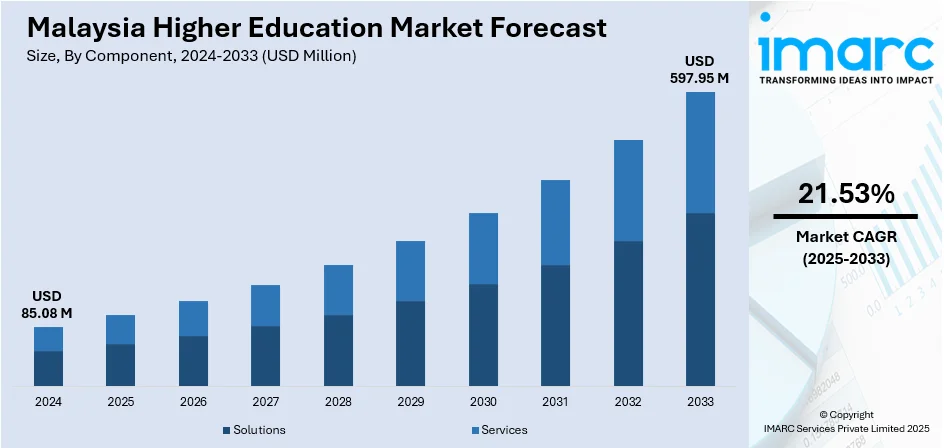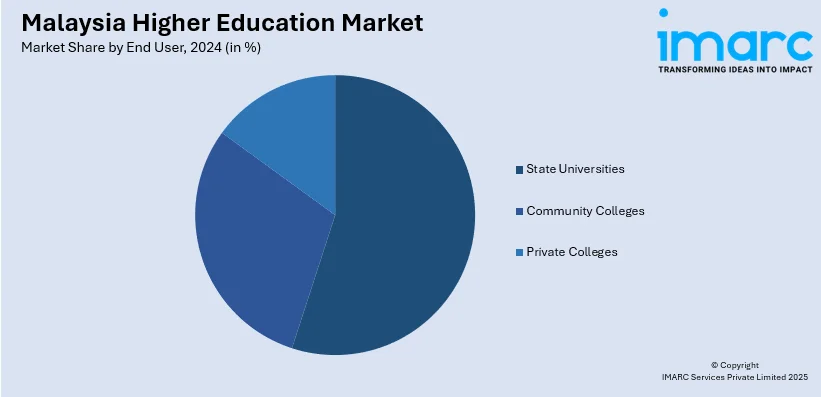
Malaysia Higher Education Market Size, Share, Trends and Forecast by Component, Deployment Mode, Course Type, Learning Type, End User, and State, 2025-2033
Malaysia Higher Education Market Overview:
The Malaysia higher education market size reached USD 85.08 Million in 2024. Looking forward, the market is projected to reach USD 597.95 Million by 2033, exhibiting a growth rate (CAGR) of 21.53% during 2025-2033. The market is driven by rising demand for skilled professionals, growing student population, and government initiatives to position Malaysia as a regional education hub. Increasing international student enrollment, along with institutional reputation, program diversity, and affordability of tuition, are some of the other factors contributing to the Malaysia higher education market share.
|
Report Attribute
|
Key Statistics
|
|---|---|
|
Base Year
|
2024
|
|
Forecast Years
|
2025-2033
|
|
Historical Years
|
2019-2024
|
| Market Size in 2024 | USD 85.08 Million |
| Market Forecast in 2033 | USD 597.95 Million |
| Market Growth Rate 2025-2033 | 21.53% |
Malaysia Higher Education Market Trends:
Growing Focus on STEM and Digital Skills
The demand for STEM and digital-focused programs is rising across Malaysian universities, reflecting shifting industry needs and employment trends. Courses in engineering, computer science, data analytics, artificial intelligence, and cybersecurity are seeing strong enrollment, especially among both domestic and international students. Institutions are updating curricula, investing in labs, and partnering with tech companies to ensure graduates are job ready. Government policies also encourage skills development in these fields through scholarships, grants, and targeted funding. For instance, in April 2025, Malaysia's Ministry of Higher Education announced its plans to introduce Malaysian Higher Education Plan, a 10-year plan focusing on Artificial Intelligence and emerging technologies. Minister Datuk Mustapha Sakmud emphasized the importance of selecting fields with strong career prospects, such as Technical and Vocational Education and Training (TVET), during the Jom Masuk U 2025 Carnival in Sandakan. As the digital economy expands, students view STEM education as a reliable path to stable, high-paying careers. Additionally, universities are integrating interdisciplinary approaches, combining technology with business and health sciences. This focus aligns academic output with industry demand and also strengthens Malaysia’s positioning as an education hub. The strong orientation toward STEM disciplines is a significant contributor to Malaysia higher education market growth.

To get more information on this market, Request Sample
Rise in International Student Enrolment
Malaysia is becoming an attractive destination for international students, particularly from countries across Asia, the Middle East, and Africa. Its attractiveness stems from reasonable tuition rates, lower living expenses when compared to Western nations, and a diverse array of programs available in English. The country’s multicultural environment and political stability further enhance its image as a welcoming education hub. Malaysian universities are actively marketing their offerings abroad and establishing partnerships with foreign institutions to facilitate student mobility and dual-degree programs. Efforts by the government, such as visa facilitation and promotional campaigns under Education Malaysia Global Services (EMGS), are also contributing to this trend. For instance, in January 2025, Malaysia's Ministry of Higher Education announced its plans to implement a centralized admissions system for international students, utilizing advanced algorithms and blockchain technology for instant qualification verification. This initiative aims to streamline the process, enhancing the country's goal of attracting 250,000 international students by 2025 amid rising interest from East Asia. Many international students are drawn to programs in engineering, business, IT, and medicine. This growing inflow of foreign students is strengthening institutional revenues and global positioning, making internationalization a key pillar of Malaysia’s higher education development strategy.
Malaysia Higher Education Market Segmentation:
IMARC Group provides an analysis of the key trends in each segment of the market, along with forecasts at the country and regional levels for 2025-2033. Our report has categorized the market based on component, deployment mode, course type, learning type, and end user.
Component Insights:
- Solutions
- Student Information Management System
- Content Collaboration
- Data Security and Compliance
- Campus Management
- Others
- Services
- Managed Services
- Professional Services
The report has provided a detailed breakup and analysis of the market based on the component. This includes solutions (student information management system, content collaboration, data security and compliance, campus management, and others) and services (managed services and professional services).
Deployment Mode Insights:
- On-premises
- Cloud-based
A detailed breakup and analysis of the market based on the deployment mode have also been provided in the report. This includes on-premises and cloud-based.
Course Type Insights:
- Arts
- Economics
- Engineering
- Law
- Science
- Others
A detailed breakup and analysis of the market based on the course type have also been provided in the report. This includes arts, economics, engineering, law, science, and others.
Learning Type Insights:
- Online
- Offline
A detailed breakup and analysis of the market based on the learning type have also been provided in the report. This includes online and offline.
End User Insights:

- State Universities
- Community Colleges
- Private Colleges
A detailed breakup and analysis of the market based on the end user have also been provided in the report. This includes state universities, community colleges, and private colleges.
States Insights:
- Selangor
- W.P. Kuala Lumpur
- Johor
- Sarawak
- Others
The report has also provided a comprehensive analysis of all the major regional markets, which include Selangor, W.P. Kuala Lumpur, Johor, Sarawak, and others.
Competitive Landscape:
The market research report has also provided a comprehensive analysis of the competitive landscape. Competitive analysis such as market structure, key player positioning, top winning strategies, competitive dashboard, and company evaluation quadrant has been covered in the report. Also, detailed profiles of all major companies have been provided.
Malaysia Higher Education Market News:
- In March 2025, SDSN Malaysia took part in the "Consolidating the Sustainability Agenda (SDG-ESG)" forum held in Putrajaya. The forum brought together 150 delegates from higher education institutions to address sustainability issues and explore opportunities for collaboration. Keynote speakers highlighted the significance of public-private partnerships in realizing the Sustainable Development Goals (SDGs) in Malaysia.
- In February 2025, Malaysia's Limkokwing University announced its partnership with Russia's Synergy University to enhance higher education, merging creative and practical disciplines. The collaboration aims to provide innovative learning experiences and address soft skills gaps, fostering cultural exchange and preparing students for the future job market, as emphasized by leaders from both countries.
- In May 2024, Malaysia's Higher Education Minister announced the launch of the country's first Faculty of Artificial Intelligence. The inaugural event was held at the World Trade Centre in Kuala Lumpur and was officiated by Prime Minister. This event marks a significant advancement in AI education in Malaysia.
Malaysia Higher Education Market Report Coverage:
| Report Features | Details |
|---|---|
| Base Year of the Analysis | 2024 |
| Historical Period | 2019-2024 |
| Forecast Period | 2025-2033 |
| Units | Million USD |
| Scope of the Report |
Exploration of Historical Trends and Market Outlook, Industry Catalysts and Challenges, Segment-Wise Historical and Future Market Assessment:
|
| Components Covered |
|
| Deployment Modes Covered | On-Premises, Cloud-Based |
| Course Types Covered | Arts, Economics, Engineering, Law, Science, Others |
| Learning Types Covered | Online, Offline |
| End Users Covered | State Universities, Community Colleges, Private Colleges |
| Regions Covered | Selangor, W.P. Kuala Lumpur, Johor, Sarawak, Others |
| Customization Scope | 10% Free Customization |
| Post-Sale Analyst Support | 10-12 Weeks |
| Delivery Format | PDF and Excel through Email (We can also provide the editable version of the report in PPT/Word format on special request) |
Key Questions Answered in This Report:
- How has the Malaysia higher education market performed so far and how will it perform in the coming years?
- What is the breakup of the Malaysia higher education market on the basis of component?
- What is the breakup of the Malaysia higher education market on the basis of deployment mode?
- What is the breakup of the Malaysia higher education market on the basis of course type?
- What is the breakup of the Malaysia higher education market on the basis of learning type?
- What is the breakup of the Malaysia higher education market on the basis of end user?
- What is the breakup of the Malaysia higher education market on the basis of state?
- What are the various stages in the value chain of the Malaysia higher education market?
- What are the key driving factors and challenges in the Malaysia higher education market?
- What is the structure of the Malaysia higher education market and who are the key players?
- What is the degree of competition in the Malaysia higher education market?
Key Benefits for Stakeholders:
- IMARC’s industry report offers a comprehensive quantitative analysis of various market segments, historical and current market trends, market forecasts, and dynamics of the Malaysia higher education market from 2019-2033.
- The research report provides the latest information on the market drivers, challenges, and opportunities in the Malaysia higher education market.
- Porter's five forces analysis assist stakeholders in assessing the impact of new entrants, competitive rivalry, supplier power, buyer power, and the threat of substitution. It helps stakeholders to analyze the level of competition within the Malaysia higher education industry and its attractiveness.
- Competitive landscape allows stakeholders to understand their competitive environment and provides an insight into the current positions of key players in the market.
Need more help?
- Speak to our experienced analysts for insights on the current market scenarios.
- Include additional segments and countries to customize the report as per your requirement.
- Gain an unparalleled competitive advantage in your domain by understanding how to utilize the report and positively impacting your operations and revenue.
- For further assistance, please connect with our analysts.
 Request Customization
Request Customization
 Speak to an Analyst
Speak to an Analyst
 Request Brochure
Request Brochure
 Inquire Before Buying
Inquire Before Buying




.webp)




.webp)












